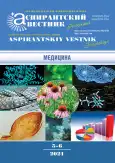Исследование антимикробной активности извлечений коры дуба черешчатого (Quercus robur L.)
- Авторы: Рябов Н.А.1, Рыжов В.М.1, Куркин В.А.1, Колпакова С.Д.1, Жестков А.В.1, Лямин А.В.1
-
Учреждения:
- ФГБОУ ВО «Самарский государственный медицинский университет» Министерства здравоохранения Российской Федерации
- Выпуск: Том 21, № 5-6 (2021)
- Страницы: 48-57
- Раздел: Фармация
- URL: https://journal-vniispk.ru/2410-3764/article/view/105764
- DOI: https://doi.org/10.55531/2072-2354.2021.21.3.48-57
- ID: 105764
Цитировать
Полный текст
Аннотация
Цель данного исследования — проведение сравнительного анализа антимикробной активности водно-спиртовых и хлороформных извлечений коры дуба черешчатого (Quercus robur L.).
Определение минимальной ингибирующей концентрации проводили методом двойных серийных разведений на питательном бульоне Мюллера – Хинтона (Bio-Rad, США). В качестве тестовых культур использовали следующие микроорганизмы: Pseudomonas aeruginosa, Staphylococcus aureus, Escherichia coli, Candida albicans.
Выявлено, что наибольшим антимикробным эффектом обладают водно-спиртовые извлечения из коры дуба черешчатого в концентрациях спирта этилового 60, 70 и 96 % в отношении штаммов микроорганизмов P. aeruginosa и C. albicans. Наименьшая антимикробная активность отмечается для 40 % водно-спиртовых извлечений из коры данного растения в отношении штаммов E. coli и S. aureus. Хлороформные извлечения коры дуба черешчатого обладают выраженной антимикробной активностью в отношении штаммов C. albicans и P. aeruginosa. Предложено в качестве оптимальной концентрации спирта этилового для коры дуба черешчатого использовать 60 %, поскольку при такой его концентрации наблюдается максимальный антимикробный эффект, а также сохраняется баланс дубильных веществ и флавоноидов в полученном экстракте.
Данное исследование будет способствовать решению вопроса вторичной переработки древесных отходов коры дуба черешчатого и рационального применения их в фармацевтической практике.
Полученные результаты могут быть использованы в дальнейшем при создании антимикробных препаратов на основе лекарственного растительного сырья «Дуба черешчатого кора».
Полный текст
Открыть статью на сайте журналаОб авторах
Николай Анатольевич Рябов
ФГБОУ ВО «Самарский государственный медицинский университет» Министерства здравоохранения Российской Федерации
Автор, ответственный за переписку.
Email: ryabov.nikolay.2014@mail.ru
аспирант кафедры фармакогнозии с ботаникой и основами фитотерапии
Россия, СамараВиталий Михайлович Рыжов
ФГБОУ ВО «Самарский государственный медицинский университет» Министерства здравоохранения Российской Федерации
Email: lavr_rvm@mail.ru
кандидат фармацевтических наук, доцент кафедры фармакогнозии с ботаникой и основами фитотерапии
Остров Буве, СамараВладимир Александрович Куркин
ФГБОУ ВО «Самарский государственный медицинский университет» Министерства здравоохранения Российской Федерации
Email: kurkinvladimir@yandex.ru
доктор фармацевтических наук, профессор, заведующий кафедрой фармакогнозии с ботаникой и основами фитотерапии
Россия, СамараСветлана Дмитриевна Колпакова
ФГБОУ ВО «Самарский государственный медицинский университет» Министерства здравоохранения Российской Федерации
Email: Sdkolpakova@mail.ru
доктор медицинских наук, профессор кафедры общей и клинической микробиологии, иммунологии и аллергологии
Россия, СамараАлександр Викторович Жестков
ФГБОУ ВО «Самарский государственный медицинский университет» Министерства здравоохранения Российской Федерации
Email: avzhestkov2015@yandex.ru
доктор медицинских наук, профессор, заведующий кафедрой общей и клинической микробиологии, иммунологии и аллергологии
Россия, СамараАртем Викторович Лямин
ФГБОУ ВО «Самарский государственный медицинский университет» Министерства здравоохранения Российской Федерации
Email: avlyamin@rambler.ru
кандидат медицинских наук, доцент кафедры общей и клинической микробиологии, иммунологии и аллергологии
Россия, СамараСписок литературы
- Буданцев А.Л. Растительные ресурсы России: Дикорастущие цветковые растения, их компонентный состав и биологическая активность. Т. 1. Семейства Actinidiaceae-Malvaceae, Euphorbiaceae-Haloragaceae / отв. ред. А.В. Буданцев. СПб.; М.: КМК, 2009.
- Государственная фармакопея Российской Федерации. XIV изд. Т. I–IV. М., 2018. [Электронный ресурс]. Режим доступа: http://femb.ru/femb/pharmacopea.php. Дата обращения: 16.04.2021.
- Гроздова Н.Б., Некрасов В.И., Глоба-Михайленко Д.А. Деревья, кустарники и лианы. М., 1986. С. 176–178.
- Куркин В.А. Фармакогнозия: учебник для студентов фармацевтических вузов. 4-е изд., перераб. и доп. Самара, 2019. С. 966–969.
- Куркина А.В. Флавоноиды фармакопейных растений: монография. Самара, 2012.
- Маевский П.Ф. Флора средней полосы европейской части России. 11-е изд. М., 2014. С. 200–201.
- Справочник лекарственных средств VIDAL [Электронный ресурс]. Режим доступа: https://www.vidal.ru/drugs/molecule-in/763. Дата обращения: 04.04.2021.
- Шагалиева Н.Р., Куркин В.А., Авдеева Е.В. и др. Актуальные аспекты разработки и стандартизации стоматологического фитопрепарата «Дентос» // Фундаментальные исследования. 2013. № 10–7. С. 1490–1494.
- Assessment report on Quercus robur L., Quercus petraea (Matt.) Liebl., Quercus pubescens Willd., cortex. EMA/HMPC/3206/2009.
- Bedi M.K., Shenefelt P.D. Herbal therapy in dermatology // Arch. Dermatol. 2002. Vol. 138, No. 2. P. 237–238. doi: 10.1001/archderm.138.2.232
- British Pharmacopoeia 2009. British Pharmacopoeia Herbal Drugs and Herbal Drug Preparations // Oak Bark. 2009. Vol. III.
- Cushnie T.P., Lamb A.J. Recent advances in understanding the antibacterial properties of flavonoids // Int. J. Antimimicrob. Agents. 2011. Vol. 38, No. 2. P. 99–107. doi: 10.1016/j.ijantimicag.2011.02.014
- European Pharmacopoeia (Ph. Eur.) 10th Edition // EDQM – European Directorate for the Quality of Medicines [Электронный ресурс]. Режим доступа: https://www.edqm.eu/en/european-pharmacopoeia-ph-eur-10th-edition. Дата обращения: 15.05.2021.
- Marais J.P.J., Deavours B., Dixon R.A., Ferreira D. The Stereochemistry of Flavonoids. In: Grotewold E., ed. The Science of Flavonoids. New York: Springer, 2006. P. 1–46. doi: 10.1007/978-0-387-28822-2_1
- Okuda T. Systematics and health effects of chemically distinct tannins in medicinal plants // Phytochemistry. 2005. Vol. 66, No. 17. P. 2012–2031. doi: 10.1016/j.phytochem.2005.04.023
- Определение чувствительности микроорганизмов к антибактериальным препаратам (Методические указания МУК 4.2.1890-04) // Клиническая микробиология и антимикробная химиотерапия. 2004. Т. 6, № 4. С. 306–359.
Дополнительные файлы







